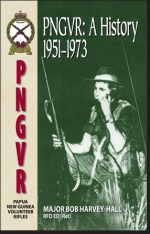Book reviews: March 2015
A Kiap’s Story: A decade in the life and work of an Australian Patrol Officer in the Kokoda, Madang, New Britain, New Ireland and Sepik Regions of Papua New Guinea 1948-1958 by Graham Taylor
Mussau Memories: Story bilong family bilong mipela by Geoff Atkins
Living on the Edge of the Universe: Paradise Can Be Hell by Richard Broomhead
PNGVR: A History 1951-1973 by Bob Harvey-Hall
A Kiap’s Story: A decade in the life and work of an Australian Patrol Officer in the Kokoda, Madang, New Britain, New Ireland and Sepik Regions of Papua New Guinea 1948-1958 by Graham Taylor
ISBN: 978-1502703453, Paperback, 402 pages, including illustrations. Pukpuk Publishing. Available from Amazon Books, Kindle, or direct from the author at tay.29@bigpond.com $25.00 plus $10.00 p&h.
At 92, and one of the very few surviving kiaps who served throughout the 30-year Trusteeship period in Papua New Guinea between the Pacific War’s end in 1945 and Independence in 1975, and having read scores of books on New Guinea, I did not expect at this late stage to come upon such a gem as this one.
Australia’s initial reluctant involvement in the New Guinea region was totally a strategic and defence consideration, and in prolonged harsh economic times, development had a very low priority.
In 1945, apart from a narrow coastal fringe and the island regions (ravaged by the war), most of Papua New Guinea remained in its stone-age slumber, substantially undisturbed by external world influences.
Then followed only 30 years of Australian administration, under United Nations Trusteeship Council direction, to independence: an extraordinarily short time to meld hundreds of mutually hostile, linguistically divided primitive tribes into a nation.
Rapid decolonisation was a high UN priority but, at the grass roots level, a vast gap had to be closed. Australia expanded its scant pre-war administrative services as quickly as human and material resources permitted.
The kiaps and their detachments of indigenous police who patrolled out into partly and totally uncontrolled areas and remained amongst the people on patrol posts in early pacification days were the total government.
In parochial habitation almost no-one ventured beyond their tribal boundaries in a lifetime. Fighting with neighbours over land was endemic, fear of attack was ever pervasive, sorcery was rife, and people remained isolated.
The kiap and his police detachment brought hitherto unknown law and order with a unifying, stable, impartial alternative to brute force and savagery and constant fear.
Graham Taylor was a product of the Australian School of Pacific Administration, Middle Head, Sydney. It evolved at Pacific war’s end from the School of Civil Affairs, which was established in 1944 with much foresight by the Army’s Directorate of Research to train patrol officers for the post war reconstruction and development of Papua New Guinea. It is here that his story begins and he skillfully weaves the relevance of law, anthropology, colonial administration and other subjects studied, into his practical field work descriptions that follow.
Some 1500 post-war kiaps passed through ASOPA over 30 years and from here their strong fraternity and bonding developed.
The author’s ten years as a patrol officer in the early days of trusteeship were in five very different regions of Papua New Guinea, whose geography is just as diverse as its people: from the idyllic blue waters and white sands of the New Ireland coast to the Guam River swamps where the inhabitants endured an unbelievably harsh, miserable, disease ridden existence.
His accounts of day to day work and life are vital and captivating. He was lucky to have served twice under legendary District Commissioner Ian Downs, OBE, who went to New Guinea in the depression of the late 1930s when his entire Navy Cadet Course was sacked on graduation.
Taylor writes skillfully and reflectively more than 50 years after he lived his story, with an outstanding communications career in between. He introduces humour, his prose is vibrant, he tells it all. He makes history live.
Fundamentally, the relationship between Papua New Guinea and Australia has always been very close. At Independence in 1975 the first Governor General, Sir John Guise, observed we are lowering the Australian flag, not tearing it down.
The part played by the kiap and his police detachment in achieving inter-tribal peace will always remain significant in Papua New Guinean history. Well could it be remembered by a joint project of the Papua New Guinea and Australian Governments in the form of a national memorial, such as an academic institution, a sporting complex or a public building of national significance.
Harry West OAM, Former District Commissioner, Territory of Papua New Guinea
Mussau Memories: Story bilong family bilong mipela by Geoff Atkins
Self-published No ISBN; 44p, spiral bound, A4 and includes b/w photos. Cost $20 plus p&p; available from Geoff Atkins at 82 Moyston Dunkeld Road, MOYSTON VIC 3377.
Geoff’s parents first went to Marovo Lagoon, Western Solomons, in 1928.
Following a brief posting to Rabaul the family spent just over 10 years on Mussau, establishing the mission and school there, before WWII intervened.
 Living on the Edge of the Universe: Paradise Can Be Hell by Richard Broomhead
Living on the Edge of the Universe: Paradise Can Be Hell by Richard Broomhead
ISBN: 978 0 9923001 4 2, Publisher: Joshua Books, 2014, 280pp, Softback, Includes Maps, photographs and index; Cost: $35 (incl postage within Aust). Available from: Richard Broomhead, PO Box 3457, HERMIT PARK QLD 4812. E: rbroom@bigpond.net.au M: 0418 182 600
Images of turquoise waters and waving coconut palms: who hasn’t dreamed of living on a remote tropical island! In 1961-62, at age 18, with the adventurous and reckless confidence of youth, Richard Broomhead accepted a job as relieving manager on a copra plantation for six months, turning into two years, in the remote Western Isles, part of the Bismarck Archipelago, PNG. The Western Isles, about 250 miles north of Madang, comprise the Ninigo and Hermit Islands and the Anchorites.
Wahlenburg, the fabled home and three storey castle built prior to WWI by Heinrich Rudolf von Wahlen on Maron, was young Richard’s first residence. Living conditions on these sometimes mosquito infested but tantalising islands were simple and creative. With no shipping lanes nearby, ships and supplies could be months apart. A request for supplies would be returned with ‘Don’t lose your grip, man’ bellowed back by the boss, Cliff Batt. Cliff, ‘King of the Western Isles’, was an unforgettable character. Central to this book he later became the oldest man to swim the English Channel!
Memorable figures such as Bill Cunningham, Tom Cole, Miles Barne, Bill Stokes, Bobby Gibbes, Harry Brutnall and Gisela Batt grace the pages and add to the feeling of time and place.
Broomhead writes this true story with a natural, lively and easy to read style. Powerful images of plantation island life are portrayed through his descriptive tale. Those who have lived in similar situations will especially relate! Interwoven through the amazing experiences of a young copra plantation manager’s life on several islands in the group is the history of these isolated Western Isles. It is both an enjoyable and compelling read! Andrea Williams
Sir Peter Barter writes: ‘I read it in one day aboard the Kalibobo Spirit, enroute to Cairns. The book is tops. Having been to Maron, Niningo, Wuvulu, Alu and many of the islands I am familiar with the region and although they are talking about a documentary, such a story would make a good movie. Wish you luck: every expat in PNG should read it.
Editor’s Note: Richard Broomhead gained his private Pilot’s licence after leaving the plantations. He eventually became Senior Check Captain with Qantas.
 PNGVR: A History 1951-1973 By Bob Harvey-Hall
PNGVR: A History 1951-1973 By Bob Harvey-Hall
ISBN: 978 0 992585532 Published by NGVR/PNGVR Ex members Assn. Cost: $50 plus $10 p&p within Australia. Available from PNGVR, PO Box 855, PARK RIDGE QLD 4125. Includes map and photographs
PNGVR was the successor to the WWII New Guinea Volunteer Rifles Militia Battalion. It was the only Australian post WWII Militia (CMF) Battalion which was:
formed, served and disbanded overseas
never served in Australia
always on the Australia’s Order of Battle
always commandeered by a regular army officer
from 1964 actively enlisting Papua New Guineans (non-Australians)
from 1964 a fully- integrated unit comprising Australians and non- Australians in all ranks
The colourful story of this unique Australian Militia Battalion unfolds in this detailed telling by Major Bob Harvey-Hall, RFD, ED (Ret), the second-longest serving PNGVR soldier/officer/Company Commander and Battalion 2/1C, from the unit’s earliest days until near when it was disbanded.
The story reveals how expatriates thought and lived in PNG from the early 1950s just after the war; how the battalion provided the initial defence of the country and assisted to re-establish the Pacific Island Regiment. As the country’s development process increased, the battalion’s role was expanded and Papua New Guineans were welcomed enlistments into the PNGVR military community.
The battalion played an important role during the anxious time the governing of West Papua was transferred to Indonesia from the Dutch. As the country rapidly moved towards its own independence there was no need for an Australian CMF unit in PNG and the unit disbanded. Many of the expatriate Australians remained in PNG after independence and further assisted the country in its development.
Read how the bonding created by the unique shared experiences within PNGVR remains strong today and is exemplified whenever a group of former PNGVR soldiers meet.
For more information, please contact Phillip Ainsworth M: 0418 730 348 or Email: p.ainsworth@kingco.com.au



